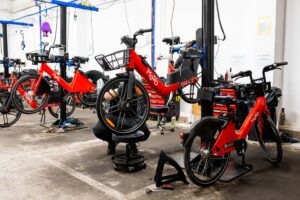Pippa Neill speaks to Jim Harkins from the All Party Parliamentary Light Rail Group about the use of trams as a tool to tackle air pollution in cities.
The first fully electric tram appeared in the UK in 1890, and as a piece of machinery it has hardly changed since.
At one point the UK was covered in trams, with networks in virtually every town and city, however as buses have become cheaper and the private car has become more readily available many tram networks have become redundant, with now just eight networks still active in the UK. As we have transitioned towards a petrol and diesel-powered transport fleet, we have been left with the consequence of air pollution.
A problem so bad that it is now estimated to kill over 60,000 people in the UK every single year.
In a desperate attempt to solve this problem, and enable the UK to reach its legally binding net-zero targets, the future of our transport system is undoubtedly electric, so perhaps it’s time to admit that we actually got it right in the 19th century.
Jim Harkins from the All Party Parliamentary Light Rail Group said: ‘Trams are better for urban pollution because there is no pollution.’ Trams are powered by electricity with an overhead wire and earth return through the steel rails, there are no tail-pipe emissions and if the tram is powered by 100% renewable electricity, then there are zero carbon emissions.
Trams are often criticised for their extraordinary cost. According to the Economist, the capital cost per mile of a tram is anywhere from £25m to £60m. Whereas a bus service can cost as little as £2.5m per mile.
However, Harkins, who has spent his career dedicated to trams and ultra-light rail, argued that the cost of trams needs to be viewed as ‘generational.’ ‘People say there’s such a tremendous cost to build trams, but if you look in some places, there are tram systems that have been running for over 140 years.’
‘Trams can last for up to 50 years, whereas a bus only lasts about 10.’
At the moment, the focus in the UK is on the transition towards electric vehicles (EV). EV sales have sky-rocketed in the last few years, with sales increasing by 140% between 2018 and 2019.
However, according to Harkins, as long as we continue to drive rubber bottomed vehicles, we continue to ignore the elephant in the room, tyre dust pollution.
According to Defra, non-exhaust emissions are responsible for the majority of primary particulate matter (PM2.5) from road transport.
Every time a tyre rotates, it loses a layer of rubber, which then blows into the air as dust and becomes a deadly pollutant once breathed in by human lungs. Research by Emissions Analytics has shown that driving a 2011 VW Golf for 320 km at high road speeds resulted in a mass loss of rubber dust of 1,844g. This equates to 5.8g per km.
And according to researchers at King’s College London this dust may be just as bad for the lungs as the PM2.5 from diesel exhausts, which has known links to brain cancer, heart and lung disease, and premature death. And yet, at the moment there is no legislation in place to specifically reduce tyre-dust pollution.
For Harkins, this is ‘outrageous’ and provides further evidence in favour of trams: ‘Trams have electric breaks, it is steel on steel, there is no friction and so no dust’ he said. One of the main battles in modern society is getting people out of their cars, whether that is to reduce carbon emissions, reduce congestion, or reduce pollution, and according to Harkins, trams are an essential part of this solution. ‘In this country, a vehicle with one passenger gets priority over a public service vehicle.
‘We need to reallocate the road hierarchy, if you’ve got a vehicle with one driver and 300 passengers, they should get priority.’ ‘Our government is so frightened of the motorists lobbying that they’ll shy away from readdressing the hierarchy, but with climate change, which we know is happening, and air pollution which continues to get worse, the more we focus on a switch to electric vehicles the more acute the problem is going to get.’
This article first appeared in the May issue of the Air Quality News magazine, which you can read here.

















Leave a Reply